The Adapter Pattern: Role and Function in Structural Patterns
- Introduction: Within the complex tapestry of software architecture, structural patterns are quintessential in articulating the arrangement and interaction of classes and objects. Occupying a pivotal role within these patterns is the Adapter Pattern, a design construct that reconciles disparities between interfaces, ensuring disparate components can interoperate seamlessly.
- Role of the Adapter Pattern:
The Adapter Pattern is essentially a bridge to address incompatibilities between interfaces. Its primary role is to enable two or more previously incompatible interfaces to work in conjunction, without altering their existing code.
2.1. Primary Roles:- Translator: At its core, the Adapter Pattern functions as a translator, taking the interface of one class and converting it into an interface that a client expects.
- Integrator: Beyond mere translation, it facilitates the integration of new functionalities or systems into existing applications, thereby allowing them to evolve without extensive code refactoring.
- Function of the Adapter Pattern:
The Adapter Pattern operates by introducing an intermediary that translates requests from one interface to another.
3.1. Key Components:- Target: The interface that clients communicate with.
- Adaptee: The existing interface that needs adaptation.
- Adapter: The bridge between Target and Adaptee. It implements the Target interface and translates its method calls to method calls on the Adaptee.
- The client interacts with the system via the Target interface.
- The Adapter receives calls to the Target interface methods.
- It translates these method calls into calls on the Adaptee interface.
- The Adaptee executes the request and returns the result, which the Adapter may transform into a format the client expects, before passing it back.
- Variants of the Adapter Pattern:
- Class Adapter: Uses multiple inheritances to adapt one interface to another. The Adapter class inherits the properties and behaviors from the Adaptee and the Target class simultaneously.
- Object Adapter: Relies on object composition. The Adapter contains an instance of the Adaptee and maps the Target interface to the Adaptee's interface.
- Advantages of the Adapter Pattern:
- Reusability: Legacy code or third-party libraries can be reused easily, even if they weren't initially designed for that purpose.
- Flexibility: New components with different interfaces can be integrated into an existing system without disrupting the current functionality.
- Isolation: Changes within the Adaptee don’t affect the client, since the Adapter can handle interface discrepancies.
- Conclusion: In the realm of structural patterns, the Adapter Pattern shines as a formidable solution to reconcile interface mismatches, promoting system extensibility and scalability. By acting as a mediator, it safeguards against extensive code modifications, ensuring software solutions remain agile and adaptable in the face of evolving requirements. In essence, the Adapter Pattern epitomizes the concept of making components work together, even when their native interfaces would suggest otherwise.
Description of the Adapter Pattern:
The Adapter pattern acts as an intermediary between two classes, converting the interface of one class so that it can be used with the other.
This enables classes with incompatible interfaces to work together. The Adapter pattern implements an interface known to its clients and provides access to an instance of a class not known to its clients. An adapter object provides the functionality of an interface without having to know the class used to implement that interace.

Benefits of Adapter Pattern:
The following lists the benefits of using the Adapter pattern:
- Allows two or more incompatible objects to communicate and interact
- Improves resuability of older functionality
When to use Adapter Pattern:
- You want to use an existing class, and its interface does not match the interface you need.
- You want to create a reusable class that cooperates with unrelated or unforesen classes, that is, classes that do not necessarily have compatible interfaces.
- You want to use an object in an environment that expects an interface that is different from the object's interface.
- Interface translation among multiple sources must occur.
In computer programming, the adapter pattern (often referred to as the wrapper pattern or simply a wrapper) is a design pattern that translates one interface for a class into a compatible interface. An adapter allows classes to work together that normally could not because of incompatible interfaces, by providing its interface to clients while using the original interface. The adapter translates calls to its interface into calls to the original interface, and the amount of code necessary to do this is typically small.
The adapter is also responsible for transforming data into appropriate forms. For instance, if multiple boolean values are stored as a single integer (i.e. flags) but your client requires a 'true'/'false', the adapter would be responsible for extracting the appropriate values from the integer value.
Another example is transforming the format of dates (i.e. YYYYMMDD to MM/DD/YYYY or DD/MM/YYYY).
The adapter is also responsible for transforming data into appropriate forms. For instance, if multiple boolean values are stored as a single integer (i.e. flags) but your client requires a 'true'/'false', the adapter would be responsible for extracting the appropriate values from the integer value.
Another example is transforming the format of dates (i.e. YYYYMMDD to MM/DD/YYYY or DD/MM/YYYY).
Adapter Pattern Java Code